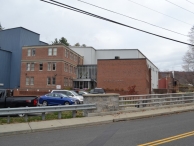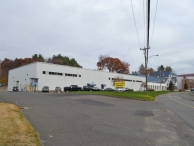Mill Record Seymour
RETURN TO ‘FIND MILLS’Disclaimer: Content for these properties was compiled in 2014-2017 from a variety of sources and is subject to change. Updates are occasionally made under Property Information, however the Connecticut Trust for Historic Preservation (dba Preservation Connecticut) makes no representation or warranty that the information is complete or up-to-date.
- Complex Name (Common)
- The Kerite Co.
- Complex Name (Historic)
-
- The Kerite Co.
- Address or Location
- 49 Day Street, Seymour
- County
- New Haven
- Historic Designation
- Associated Mill Community
- n/a

- Historic Information
Companies Associated w/Complex
- A.G. Day Co. ca. 1880-1892
- H.P & E. Day Co. ca. 1880s-ca. 1905
- J. Day Co. ca. 1865-ca. 1880s
- Kerite Insulated Wire & Cable Co. 1908-ca. 1950
- The Kerite Co. ca. 1950-Present (2015)
- W.R. Brixey Kerite Telegraph Cable Works 1892-1908
Use (Historic)
Largest Documented Workforce
200-299 (1939).
Historic Narrative
The origins of the Kerite Insulated Wire and Cable Company date to 1854 and the organization of the A.G. Day Company by Austin Goodyear Day, a native of West Springfield, Massachusetts and cousin of the renowned rubber manufacturer and New Haven, Connecticut native, Charles Goodyear. Day worked in the laboratory of Goodyear’s Woburn, Massachusetts rubber goods factory before moving to New Haven in an effort to establish his own manufactory during the early 1850s. In 1854, Day purchased a mill in Seymour, Connecticut formerly occupied by the firm of Bassett and Hodge. Here he began manufacturing telegraph cables and electrical wiring that featured Kerite, a proprietary rubber insulation product. The business represented a merger of two of the most prominent fields of industrial production in the Naugatuck River Valley, rubber and copper goods. Day’s factory was destroyed by fire in 1864, however, the plant was replaced the following year. The new mill was largely given over to the production of submarine telegraph wire, of which the A.G. Day Company rapidly became a global leader. A.G. Day also shared the new facility with the J. Day Company, a firm operated by Day’s brother Julius that manufactured small rubber goods such as pencil and pen holders. Julius Day lead this company until the 1880s, whereupon it was assumed by two of his brothers, Henry P. and Edmund Day. Austin G. Day died in 1889, after which control of the Kerite plant passed to William R. Brixey, a long-time employee of the company. Brixey greatly expanded both the plant’s size and output, primarily focusing on the manufacture of submarine, aerial, and underground electric cables. Among the firm’s customers were the Western Union Telegraph Company, Postal Telegraph Company, New York Telephone Company, and the United States Government. The business operated as the W.R. Brixey Kerite Telegraph Cable Works from 1892 until 1908 when the firm was reorganized and incorporated as the Kerite Insulated Wire and Cable Company. Substantial additions to the Kerite plant were completed during the mid-20th century, and a plant located a short distance to the southwest – formerly occupied by the S. Smith Paper Company and then the Rimmon Manufacturing Company – was acquired by Kerite around 1925. The firm operated as the Kerite Insulated Wire and Cable Company until around 1950, after which it was identified simply as The Kerite Company. It continues to maintain its Seymour plant, which was substantially enlarged circa 2000.
- Architectural Information
Number of Existing Buildings
Roughly twenty (20) adjoining primary blocks.
Dates of Construction
ca. 1854, ca. 1890, ca. 1920, ca. 1930, ca. 1940, 1946, ca. 1960, ca. 2000.
Architect
n/a
Builder
n/a
Building Type
Architectural Description
The Kerite Company plant is comprised of a cluttered amalgam of roughly twenty primary adjoining blocks located on the north side of Day Street and the Bladens River, just east of Day Street’s intersection with New Haven Road (CT Route 67). The oldest portion of the plant was erected ca. 1854. This consists of a two-and-a-half-story frame residence presently located at the center of the complex. Originally the home of Austin G. Day, the house was converted for use as the factory’s offices ca. 1920. The house appears to have been built as an Italianate style structure, yet was remodeled in the Queen Anne style ca. 1890. The building measures roughly 60’ x 54’ and has both clapboard and fishscale shingle siding, double-hung windows in both two-over-one and one-over-one arrangements, a wide frieze, widely overhanging side-gabled roof with exposed rafter tails, and two front-facing cross gables. A prominent one-story porch wraps around the front (south) and side (east and west) sides of the building and connects to a one-story porte-cochere on the west side of the building. The porch has turned supports and balusters and a hipped roof. The oldest surviving factory block associated with The Kerite Company plant appears to be a one-story, 50’ x 54’ red brick boiler house situated directly north of the dam that previously provided power to mill. The boiler house was built ca. 1890 and it formerly adjoined the southern end of a three-story red brick mill erected in 1865. The latter was demolished along with several early-20th century manufacturing buildings ca. 2000, whereupon they were replaced with a two- and three-story, 210’ x 215’ steel-frame block that now comprises the core of the complex. The new manufacturing building has a concrete foundation, corrugated metal siding, and a flat roof. A pair of historic red brick blocks, one erected in 1946 and another built ca. 1960, project from the ca. 2000 building’s west elevation, while a cluster of one-story brick and concrete block buildings erected during the 1920s and 1930s adjoin its eastern elevation. The latter housed the mill’s insulating, mixing, and grinding departments, and link the core of the plant to a cluster of roughly seven blocks built on the eastern side of the plant during the 1940s, 1950s, and 1960s. These have a combined frontage of roughly 550’ and a maximum depth of around 125’. The majority are of red brick construction have concrete foundations and flat roofs. Significant additions to The Kerite Company plant were completed on the western side of the plant ca. 2000. These consist of three one- and two-story metal frame blocks erected adjoining the west elevation of the aforementioned ca. 2000 block and extending 550’ to the west directly north of and past the office building. From east-to-west the three blocks measure 266’ x 50’, 116’ x 50’, and 278’ x 102’, respectively. All have concrete foundations, corrugated metal siding, and flat roofs.
Exterior Material(s)
Structural System(s)
Roof Form
Roof Material
Power Source
Condition
Fair
Condition Notes
The complex is in fair condition. Although several of the plant’s earliest blocks have been demolished, those that remain appear to be structurally sound.
- Property Information
-
Specific Location
One legal parcel (49 Day Street) totaling 23.24 acres located on the north side of Day Street and the Bladens River, just east of Day Street’s intersection with New Haven Road (CT Route 67).
Adjacent To
Exterior Visible from Public Road?
Yes
Parcel ID / Assessor Record Link
- 9/10/1 / Link →
Acreage
23.24
Use (Present)
- Sources
-
Form Completed By
Lucas A. Karmazinas
Date
11/05/2015
Bibliography
- List of Connecticut Manufacturers, 1922, 1924, 1930, 1932.
- Directory of Connecticut State Manufacturers, 1936, 1939.
- Industrial Directory of Connecticut, 1947.
- Register of War Production Facilities in Connecticut, 1951.
- Map of New Haven County; Clark, Richard, 1859.
- Atlas of New Haven County, Beers, Ellis & Soule, 1868.
- Aerial Survey of Connecticut, 1934, 1965.
- Sanborn Map Company, 1884, 1890, 1895, 1900, 1906, 1911, 1924, 1949.
- Waterbury Directory; Various editions.
- History of Waterbury and the Naugatuck Valley, Connecticut, 1918.
- Tercentenary Pictorial and History of the Lower Naugatuck Valley, 1935.
- Roth, Matthew, et al, Connecticut: An Inventory of Historic Engineering and Industrial Sites (Washington DC: SIA, 1981).
- Representative View(s)Click on image to view full file








